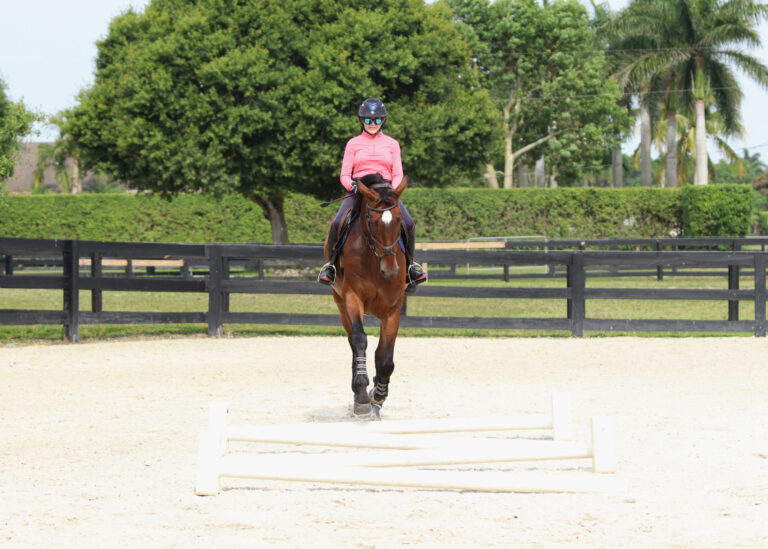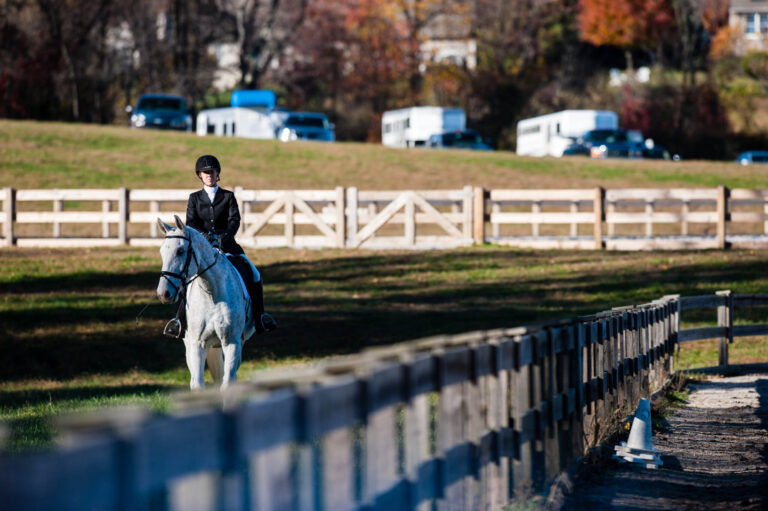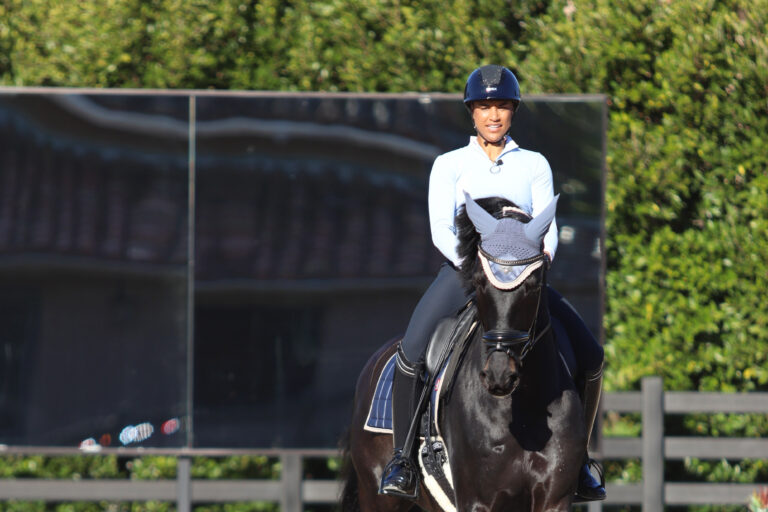One of the most important aspects in an event horse’s training is exposure to cross-country water jumps. With a positive, well-planned introduction, you can avoid the all-too-frequent heartaches that many riders experience when their horses refuse or are eliminated at this inherently challenging element. In this two-part series, I will walk you through the training plan that I follow with both green and experienced horses. This month, I will help you see water jumps through your horse’s eyes and will explain how to overcome his initial fear and hesitation in your first training sessions. Next month, I’ll show you how to teach him to jump fences in combination with water.

Let’s begin by recognizing exactly how difficult this task is. Horses don’t magically go into water without being trained to do so. Most have a natural wariness of it because they cannot easily judge its depth or the quality of the footing underneath it. Even the bravest horses need to be reassured that they will only be asked to tackle safe, doable water jumps.
Building your horse’s trust in you, however, is more than just a matter of getting his feet wet once or twice; it requires multiple, enjoyable, logically progressive schooling sessions. In addition to building his confidence, these sessions must teach him how to approach, enter and exit the water in a steady, balanced, relaxed manner, maintaining the same speed and stride length from beginning to end. These are fundamental skills necessary for safely and cleanly negotiating obstacles into, out of and in the middle of water jumps—challenges he will face as he moves up through the levels.
When you see a horse make a spectacular leap into water, however impressively brave it may seem, he’s actually revealing a lack of education. A well-schooled horse should pop into the water and over each obstacle with minimal fanfare, making it look almost boring.
No Bad Memories
Achieving this level of comfort requires a step-by-step, multiday—even multiweek—plan involving a carefully selected venue, uniquely qualified helpers and a patient yet determined attitude. In each schooling session, you must be prepared to spend as much time as necessary to reach a happy conclusion without ever getting mad or frustrated. The goal is to make water fun and easy so your horse never dreads going in. A single bad experience can leave an indelible mark on his memory. If you allow a session to escalate into a battle of wills with excessive whipping, spurring and hollering, every time your horse faces a water jump after that, he’ll have flashbacks to that experience and will think, “Oh no, here’s where I get beaten.”
Even if your horse’s first water school goes well, you must reinforce that success with additional positive memories. Just like a fisherman whose great catch gets bigger every time he retells the story, your horse may mentally exaggerate his first water venture over time. Weeks after coming home to tell his barn-mates, “It wasn’t so bad,” he may begin to remember the water as having been 10 feet deep and terrifying.
That’s why it’s so important to follow the first school with many additional sessions, both in the short term and periodically throughout his career. Even four-star horses with excellent foundations need occasional water schools in between competitions. In fact, the water questions they encounter on course are so challenging that they often need to practice simpler exercises at home to bring their confidence meters up. As is true in so many other areas of horsemanship with horses of all levels, the best rule of thumb is to school water “little and often.”
For many eventers in the U.S. who have limited access to suitable schooling facilities, this may sound like a near impossible task, especially for those based in the West, where even natural water resources are scarce. This is a disadvantage, but it doesn’t have to be a deal-breaker. Think about how much money you invest in a single competition. Then imagine throwing all that money away by getting eliminated at the water jump. You’ll be much better off spending the same amount of money trailering to a good schooling facility—even if it’s hours away—and hiring a professional to guide you through the process. Making your horse’s water education a top priority will be well worth the investment in the long run.
Make a Plan
A young and/or green event horse can be introduced to water as soon as he’s trotting and cantering on the flat and over fences in the ring, hacking outside the ring and going up and down hills under control. Give him this invaluable education before his first competition or clinic to avoid the potentially crippling fear created by a negative experience. Incorporate the following factors into your introductory schooling plan:
1. A suitable schooling facility. Legendary U.S. Eventing Team Coach Jack Le Goff used to say, “It’s possible to teach a horse to jump into a swimming pool—once!” In other words, you will lose your horse’s hard-earned trust if you ask him to do something unreasonable. Be sure that every body of water you ride him into has the following qualities: footing that is firm and level, not muddy or boggy; water no deeper than 24 inches; and overall dimensions of at least 24 feet wide and 24 feet across. Anything narrower than that might invite your horse to jump the entire thing. Finally, your chosen water jump’s introductory-level entrances and exits should be invitingly gradual—no steep Man From Snowy River banks!

Our farm’s water complex has an added benefit of banks on either side of the lower-level entrance, which serve as wings. They help to channel the horse into the water both physically and mentally. We keep the complex filled all the time so it is available for daily schooling year-round.
For riders who don’t have easy access to a water jump specifically built for eventing, think twice before practicing in a nearby creek, stream, pond or lake. Such natural features can actually add to a horse’s fear and distrust if they contain steep, rocky banks; boggy, sticky footing; deep water; strong currents or any other potentially disconcerting characteristics.
2. A good support team. All amateur eventers should introduce their horses to water with the assistance of a knowledgeable, qualified trainer, ideally mounted on a quiet, experienced horse. As I’ll explain later, having a “Steady Eddy” equine companion who can tell your horse, “Hey Dude, it’s no big deal,” while accompanying him into the water is the best way to instill confidence. It’s important that this companion be extremely calm and unflappable, as he may have to tolerate some dramatic behavior on your young horse’s part, such as big “leaps of faith” into the water.
You may also find it helpful to have a ground person with a longe whip willing to stand at a safe distance behind your horse as he approaches the water. This person’s role will merely reinforce your “go forward” message in an encouraging—never abusive—way.
3. Proper equipment. One of the pieces of tack I never go without on cross country is a breastplate with a strap across the withers. This provides you with something to hold on to so you don’t risk pulling on the reins and punishing your horse in the mouth accidentally if he suddenly launches into the water and throws you off balance.
4. Plenty of time. As I mentioned previously, to guarantee your horse a positive experience in the water, you must give him the feeling that there’s no rush. When time is tight, tempers flare and horses quickly pick up on your negative emotions. This is why a clinic is not the best scenario for introducing a horse to water. Clinicians are obligated to spend time on other horses and riders and other cross-country elements. Instead, for your horse’s early water lessons, plan to focus entirely on him and the water jump. Even if you travel a long way to a schooling facility, if you arrive late in the day, don’t try to squeeze in a practice session that evening and risk running out of daylight.
Getting Started
In the beginning of each schooling session, warm up over a few easy, straightforward cross-country fences—logs, coops, etc. The goal is to get your horse feeling confident and in front of your leg (forward and responsive to your leg aids). Be careful not to overdo it, though. Especially when you’ve gone to great logistical and financial lengths to set up a cross-country school, it may be tempting to get your money’s worth by jumping every obstacle on the course. This increases the risk of you and/or your horse arriving at the water jump mentally and physically fatigued, which can drastically reduce your chances of success.
When you feel adequately warmed up, approach the water jump in an active, purposeful walk. Sit squarely and securely in the center of the saddle with your legs wrapped around your horse’s sides, holding the breastplate strap with one hand. In your initial approach, have your lead horse follow several feet behind you so you can see how your horse reacts to the water on his own. This will give you a good reading of his aptitude for the sport. If he walks into the water with little hesitation, that’s a good sign. However, if he hesitates or stops, that’s not necessarily a bad sign. Many top-level horses are cautious about water in the beginning of their careers.
Your reaction to hesitation is critical. Think offense, not defense. Immediately encourage him with a cluck, a nudge of your legs and perhaps a tap with the stick on his shoulder. Be firm and positive but committed to preventing the situation from escalating into a fight. Give him a chance to test the water. Allow him to sniff and paw at it if he wants to. Then gently ask him to step in. Whatever you do, don’t turn him away from the water’s edge. Trying to re-approach from a longer distance or at a faster speed will only get you stuck farther away from the water. Instead, hold your ground and make it clear that his only option is to go forward.
If after a few minutes he is still unwilling to step into the water, ask your companion on the lead horse to walk alongside him and clip a lead rope to his bit. Then ask her to walk her horse calmly forward into the water, simultaneously giving a gentle tug on the lead rope. Nine times out of 10, the green horse will follow the experienced horse into the water. Again, be prepared for a dramatic leap—and ready to praise your horse the moment he takes it.
If he still isn’t willing to enter the water at this point, it may help to have a ground person stand behind him—far enough back to be safe from a kick—slowly waving a longe whip to reinforce your forward aids. She can even lightly tap him on the haunches with the whip. Again, be very careful to keep the mood encouraging, not punishing.
In extremely rare cases, it may be necessary for you to dismount and remove all of your horse’s tack. Your expert on the lead horse can then work directly with your horse to persuade him to enter the water. This can be especially beneficial if you are inexperienced and/or anxious about the situation. With time and patience, even the most stubborn horses can be convinced in this way to overcome their fears.
Once your horse is in the water, he may still want to sniff and paw at it, familiarizing himself with these new sensations. Give him time to do this. Then quietly exit the water and re-approach it in the same positive, forward way you did before. Do this several times until he’s walking into and out of the water confidently.
Throughout this first session and the next several ones, do everything at the walk, asking your horse to maintain the same speed and stride length as he crosses the water. Save trotting—which creates more of a splash and requires more effort to move through the water—for the fourth or fifth schooling session.
If your horse is entering and exiting the water fairly confidently after 10 or 20 minutes, leave the water to do something else briefly—for example, jump a few other types of fences. Then, if he still feels fresh and positive, come back to the water at the end of your ride for one more mini-session. This way, you get two schools in one.







Trotting Through Water
Once you’ve gotten your horse’s feet wet for the first time, your job is far from done. Even if he seemed confident, it’s important to follow up with another session to reinforce the lesson and quell any initial worries he had. If you’ve traveled a long distance to a schooling facility, plan to stay there for a number of days to fit in these invaluable follow-up sessions. Otherwise, find a way to get to a water jump again soon—ideally within a few days.
After the first two or three schooling sessions, you should have a good idea of your horse’s comfort level. If he is on the braver end of the spectrum, he may need only occasional refreshers every few weeks or so. If he’s on the more cautious end, he may need to revisit the water daily or near daily for several weeks. When we have green horses sent to us for intensive training periods, we take them down to the water jump almost every day, even in their dressage saddles after a flat school.
As your horse’s confidence grows, follow a logical, step-by-step training process, building on his skills gradually and giving each new challenge time to sink in. After several successful sessions at the walk, try trotting into and through the water. Be prepared for his reaction to the new sensation of water splashing in his face. Also continue to encourage him to regulate his speed and stride length throughout the exercise, just as you did at the walk.
Depending on how much access you have to a good water complex, it may take your horse weeks or even months to graduate from this phase of his training. Give him plenty of time to solidify this foundation. The more confidently he is walking and trotting through a simple water question, the easier it will be to introduce him to the next step: jumping obstacles in combination with water. I’ll explain how to do that next month.




Mike Huber

Veteran eventer Mike Huber represented the U.S. in three World Championships and one Olympic Games. At the 1987 Pan American Games, he and Quartermaster won both the individual and team gold medals. A past president of the U.S. Eventing Association, former chairman of the U.S. Equestrian Federation Eventing High Performance Committee and longstanding member of the USEF Eventing Technical Committee, Mike also served as an Olympic selector from 1996 to 2000 and from 2009 to 2012. He owns and operates Gold Chip Stables—named for the little mare he competed in the 1980 Alternate Olympics—in Bartonville, Texas. A USEA-certified Level IV instructor, he gives many clinics nationwide. The USEA formally inducted him into its Eventing Hall of Fame in 2015.
This article originally appeared in the April 2016 issue of Practical Horseman.











